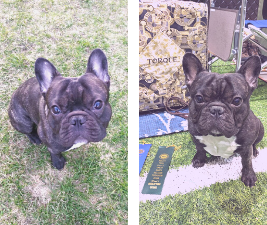Dogs don’t generalize. Not situations, objects, behaviors, nothing.
There’s a saying in dog training – every dog’s a trial champion in the kitchen. And that pretty much sums up the entire difference between people and dogs.
Brain differences
Hope came up with a pretty good analogy explaining this to her obedience competition students this week. When you learned how to use a fork, you knew how to use a fork. No matter what the fork looked like. Or what it was made of. Everyplace you ate a meal, you still knew what a fork was for and how to use it. That’s “generalizing” the behavior.
Dogs have to be taught to do that. Not use a fork. Generalize behaviors for all places and situations. Just because your dog knows how to “sit” on command everywhere in your house doesn’t mean he’ll know how outside. Or at the vet’s office, park, training class, pet supply shop.
Not starting from zero

Dogs will pick up on the similarity pretty quickly. But it stymies people at first when they stumble across this fundamental difference between people and dogs. Just today, a young couple was telling us that their wonderful, 12-week-old puppy knows how to sit, stay, lie down, even “give paw” when they’re at home. But when they took her to the vet and tried to show off her skills, she knew nothing.
A puppy that young doesn’t really “know” any of the behaviors reliably, of course. Instead, she knows that when her people act a certain way and make those sounds, she’ll get a treat if she does something. So she does something. (By the way – whenever we think about what dogs hear when we talk, we get a mental cartoon of the Peanuts gang listening to adults. Don’t you?)
Analyze your own behavior
Chances are your dog is picking up lots of cues from you to indicate which “thing” you want him to do. At some point they do recognize actual words you’re using. But, especially early on, most of the information your dog understands comes from body language. If you always hold the treat in a certain hand and use a gesture when you say “sit,” all of those things are part of the dog’s understanding of what you want.
Competition obedience requires that certain commands be either word or gesture. Not both. And some dogs are better at understanding voice commands, others prefer the visual. When we first discovered this with our own dogs, we thought it was fascinating that, once again, dogs are just like us! Some people learn better by listening, others by reading.
Generalize can spreads like crazy
Once your dog understands the concept “here is the same as home” the notion will spread fast. Dogs can learn to generalize. Most times you don’t have to re-teach the idea for every behavior. As long as you stay consistent with your words and body language, your dog will understand what you’re asking. But be sure to remember the treats!








